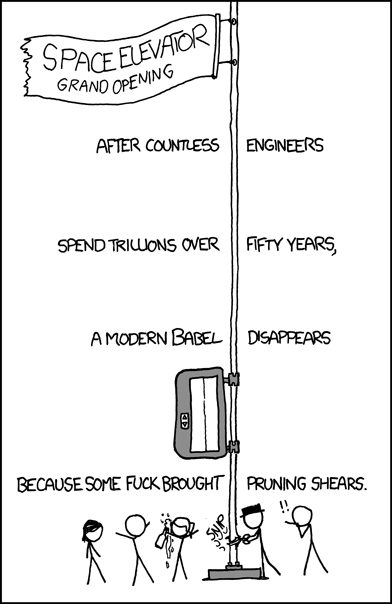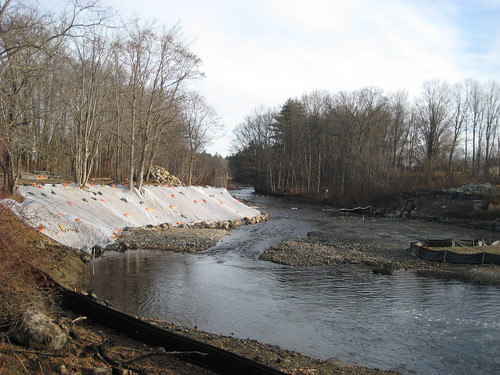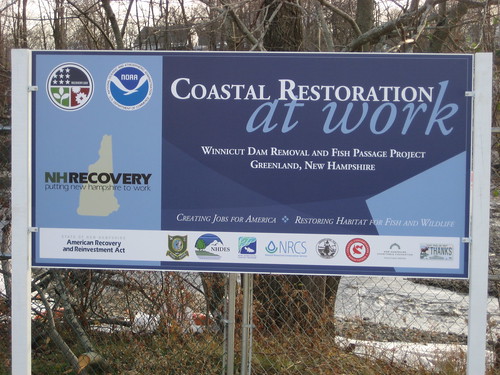Tangentially via a tweet from @snarky_malarkey, a slide show of shipping container dwellings. My earlier musings on containers are here. The tree house slide show that led me to the containers got me thinking – my Goff/Bavingeresque cable and phone pole hack ought to include a nice big beech or oak at the center. Another thought: not sure how to integrate it, but a waste container based aquaponics rig should fit in somewhere (ground level, obv).
Category Archives: infrastructure
The big transformer move revisited
I posted last June about the move of a large transformer down through Crawford Notch to the Saco Valley substation. Public Service of NH just put up three YouTube videos documenting all phases of the move. Here’s a YouTube playlist that will (I hope) string all three together:
*
The Transformer on Rails main page is here.
Tatra 68
Burma-Shave
Bruce Sterling: The Hypersurface of this Decade
Simultaneously hilarious and mind-expanding (one of my favorite combinations).
Freedom is just another word for nothing! There is no dead weight in my urban spatiality. No clotted semiotics, cajoling me to behave in the stereotyped haute-bourgeois manner that Deirdre once used to stifle me.
Dematerialisation is defined by its interfaces. That which was product will become a service. That which was a service will accelerate at warp speed toward de-monetisation on the Path-to-Free. So this is not so much a post-divorce flat as a vibrant zone of interactive transaction.
Bruce Sterling: The Hypersurface of this Decade | ICON MAGAZINE ONLINE.
‘sproke: Augmented Reality Resources for Software and Hardware
‘sproke: Augmented Reality Resources for Software and Hardware.
Via Bruce S.
Hopefully our future dream isn’t this particular (shopping) scheme:
Winnicut River Dam Removal
On my way back from the salt marsh yesterday morning, I swung past the Winnicut River. I’d been hearing about the dam removal project on the radio and wanted to see what things looked like – the answer is: much changed from the last time I was there.
In 2007, the owners of the Winnicut Dam – the New Hampshire Fish and Game Department – decided to remove the dam after an extensive study determined that its removal would be the best option. It is the last remaining barrier on the mainstem of the Winnicut River and its removal effort, which also includes the installation of a fish passage structure upstream, will open more than 39 miles of upstream habitat for migratory fish such as alewives, blueback herring, and American eel. *
I took some photos (below) – there’s also a webcam and a blog if you’d like to see what things looked like before and during the removal.
Old bridge abutments and the highway above.
*
Downstream.
*
One neat thing about projects like this is all the interesting trash that gets revealed.
*
Great find – Domebook 2/Living Structures
I am a DFH at heart, so I was ecstatic to fall over scans of both Domebook 2 and How to Build Your Own Living Structures on the new-to-me and awesome Public Collectors site. Thanks, Greg Allen.
The first thing we do, let's…
…and the bankers and the talking heads. Via TPM comes this truly appalling clip of Nouriel Roubini and Nassim Taleb on CNBC. Roubini and Taleb are talking about a systemic crisis and the needle that they think we need to thread to get through it; in contrast the network talking hairstyles want stock tips. I suppose it’s progress that the traditional media are talking to folks that actually got it right, rather than their usual practice of canonizing those who dug the hole we find ourselves in (obviously – given the title of the post – I’d prefer cannonizing them). I’m beginning to believe that a piece of the institutional failure we’re seeing can be attributed to our ruling elite’s love of going meta – don’t pay attention to the content of the argument, instead, warn your guests about the dangers of being a rock star and marvel that Bill Gates would actually wait in a line to hear your guests speak. The rage in the hinterlands may be breaking through the Villager’s (DFH-speak for the elites) carefully constructed bubble; Diane Rehm – usually the Villager-est of softball, conventional wisdom interviewers – was amazed at the platitudes spewed by her banking industry guests yesterday (check out that guest lineup though – now those are some wild and radical gets *sarcasm*).
*
Rather than stock tips, what might actually be useful are some thoughts on the future of unemployment. Somebody twittered this link – whoever it was – thanks.
Start with the numbers: worldwide, the UN estimates as many as 51 million people could become unemployed this year. Here in Britain, if the analysts are right, one million people who currently have jobs won’t do in twelve months’ time. What happens next for those people will shape the kind of society we live in, over the next decade and beyond.
I want to think about some of the ways this situation could play out. In particular, I’m interested in whether the things we’ve learned from social media over the last few years can play a role in lessening the hardship of this recession and shaping the world which comes out the other side. *
*
Finally, a blog that’s going on the blogroll real soon now – Boone, Johnson and Kwak’s Baseline Scenario.
The Baseline Scenario is dedicated to explaining some of the key issues in the global economy and developing concrete policy proposals. Since it was launched in September 2008, articles on this blog have been cited by The Wall Street Journal (Real Time Economics), The Economist (Free Exchange), The Financial Times, NPR (Planet Money), and many other sites around the Internet. The authors of the blog have also published articles in The Washington Post and in the online editions of The Wall Street Journal, The Financial Times, The Guardian, Forbes, Bloomberg, and Reuters. The blog was the subject of an interview with Simon Johnson in The Wall Street Journal. Content from The Baseline Scenario is currently republished by Seeking Alpha, Talking Points Memo Cafe, and RGE Monitor. *
*
You’ll know I’m really pessimistic when I start posting recipes for long pork.
The future – here, but not widely distributed
Three quick forward-looking links.
Crooked Timber is doing a Charlie Stross book event.
A New Year, a new Crooked Timber book event. But instead of one book, we’re covering a dozen or so, all written by Charlie Stross, exploring different forms of the SF genre from postcyberpunk to alternate history and beyond. For this we need an all star cast, and, in addition to several CT regulars (Henry, both Johns and Maria), we have contributions from Paul Krugman, Brad DeLong and Ken MacLeod. Between us, we’ve managed to cover nearly everything. Glaring exceptions include the Laundry series, which every fan of Len Deighton and HP Lovecraft should read, and Glasshouse. I’ve added an open thread at the end of the seminar, for those who want to discuss what we missed.
*
Geoff Manaugh is getting close on the BLDGBLOG book. Close enough, in fact, that he’s posted some Wordle word clouds – looks like it’s going to be an interesting read.
*
At City of Sound, The Personal Well-Tempered Environment.
SUMMARY
- A real-time dashboard for buildings, neighbourhoods, and the city, focused on conveying the energy flow in and out of spaces, centred around the behaviour of individuals and groups within buildings.
- A form of ‘BIM 2.0’ that gives users of buildings both the real-time and longitudinal information they need to change their behaviour and thus use buildings, and energy, more effectively. An ongoing post-occupancy evaluation for the building, the neighbourhood and the city.
- A software service layer for connecting things together within and across buildings.
- As information increasingly becomes thought of a material within building, it makes sense to consider it holistically as part of the built fabric, as glass, steel, ETFE etc.
Enormous lacuna
How in the world did I not know about this? Trains, model making and everything shitty about the 70’s – SUPERTRAIN!
The series took place on the “Supertrain”, an imagined nuclear-powered bullet train that was equipped with amenities more appropriate to a cruise ship than a train, such as swimming pools and shopping centers. It was so big it had to run on very broad gauge track (not two sets of tracks as depicted in some advertising). The train took 36 hours to go from New York City to Los Angeles. Much like its contemporary The Love Boat, the plots concerned the passengers’ social lives, usually with multiple intertwining storylines, and most of the cast was composed of guest stars. The production was elaborate, with huge sets and a high-tech model train for outside shots.
At the time, Supertrain was the most expensive series ever aired in the United States. The production was beset by problems, including a model train that crashed, and while it was heavily advertised during the 1978-1979 season, it suffered from bad reviews and low viewership; despite attempts to salvage the show by reworking the cast, it never took off and left the air after only three months. *
*
Special guest stars: Dandy Don Meredith, Vickie Lawrence, and George Hamilton. It’s got success smeared all over it!
*
The only other atomic locomotive that I can think of offhand is the mighty Dreadnought in Harry Harrison’s A Transatlantic Tunnel, Hurrah! ATTH is both a good piece of alt history (as I’ve said before, a genre prone to “what if the Spartans had a nuke?” crapola) and a bit of proto-steampunk (I guess by IDing it as steampunk, the alt history is a given).
Googling ‘atomic train locomotive’ turns up a late-50s ‘how I stopped worrying and learned to love the bomb’ train set – the Kusan KF-100 Atomic Train. A youtube clip of the train in action (sorry, pas de mushroom clouds):
Smart Grids
It was this article that got me started thinking about it – the money graf:
Around the corner at Madigan Lane, John Sweeney, a member of the town’s conservation-minded Heat Advisory Committee, took a characteristically green approach to powering his home during the storm. He reported his achievement in an e-mail, saying it was no big deal, but that his wife thought it an impressive tale worth sharing: Sweeney ran his refrigerator, freezer, TV, woodstove fan, and several lights through his Prius, for three days, on roughly five gallons of gas.
Up here in New England we just got through a short duration disaster (the ice storm). As a country (and globally), we in the beginning of a longer term disaster – the current recession/depression. One of the factors that kicked the recession into high gear (IMHO) was the spike in oil prices last summer and fall – the spike affected consumer spending directly – less money spent on other things – and indirectly, as people tightened their belts. Like it or not, it’s consumer spending (particularly American consumer spending) that has driven the global economy for decades. Oil prices have dropped recently (in large part because of the global economic contraction) – I don’t think that relying on energy costs staying low is a good bet. Kunstler’s take:
Many were stunned this year to witness the parabolic rise and fall of oil prices up to nearly $150 and then back around $36 by Christmas time. Quite a ride. I said in The Long Emergency that volatility would be the hallmark of post peak oil because it was obvious that advanced economies could not absorb super high prices and would crash in response; that at some point after crashing, these economies would respond to the new lower oil price, resume their cheap oil habits, and build to another price rise. . . and crash again. . . in a declension of ever-lower industrial activity.
What I probably didn’t realize at the time was how destructive this cycling between low-high-and-low oil prices would actually be in the first instance of it, and what a toll it would take right off the bat. We can see now that our first journey through the cycle took out the most fragile of the complex systems we depend on: capital finance. As a result, a huge amount of capital (say $14 trillion) has evaporated out of the system, never to be seen again (and never to be deployed for productive purposes). It will be harder for the USA to rebound from the grievous injury to this crucial part of the overall system, and Europe has foundered similarly — though the European nations are not burdened to the same degree by the awful liabilities of suburbia. *
JHK may be too pessimistic, but to put things in context – last spring (I think) a friend put Nouriel Roubini (aka Dr. Doom) in context by describing him as the James Howard Kunstler of economics. On December 3, 2008, Nassem Taleb – author of The Black Swan – suggested that Roubini is an optimist. What’s that saying – hope for the best, plan for the worst?
So – three things – severe weather (say what you will about climate change, but from a risk/reward perspective, the chances of climate change being real need to be down near zero if you want to justify staying the course), volatile energy costs and a recession that militates heavily for big government spending – if I could do a 3 circle venn diagram a la Indexed, one of the things in the climate/energy/spending intersection would be smart grids. I was a little surprised to find – as the result of a lunchtime rantlet – that some folks haven’t been exposed to the notion. A smart grid is not a thing – it’s a bunch of desired outcomes and technologies to achieve those results.
Before examining particular technologies, a proposal can be understood in terms of what it is being required to do. The governments and utilities funding development of grid modernization have defined the functions required for smart grids. According to the United States United States Department of Energy‘s Modern Grid Initiative report,[11] a modern smart grid must:
- Be able to heal itself
- Motivate consumers to actively participate in operations of the grid
- Resist attack
- Provide higher quality power that will save money wasted
- Accommodate all generation and storage options
- Enable electricity markets to flourish
- Run more efficiently *
Bullets 3, 5 and 7 are of particular interest to me. Efficiency – wasting less – is one of the most important ways to go after climate change and energy costs. There is no free lunch – there are costs associated with any kind of power generation – but improvements in efficiency are as close to a free lunch as we’re going to find. Bullet 5 touches on the Prius example I started the post with. A lot of non-fossil energy options are intermittent – wind is probably the classic example. Being able to do some curve-smoothing by storing/releasing energy in a fleet of plugged in hybrids? Interesting. Bullet 3 ties back to climate from the other side – as weather gets more severe, being able to resist disruption is a very good thing. Bullet 3 also links nicely to John Robb’s concept of resilient communities. There are tension here as well – at least for the purposes of this post. I’m arguing that the Federal government ought to spend some money on implementing (not just designing/armwaving) a smart grid – Robb argues that resilient communities must be bottoms-up and self organizing. Given that my chances of affecting prez-elect Obama’s decisions on anything are virtually nil, I’ll kick that objection under the rug. I do think there’s an example where we meet in the middle, though – you’re soaking in it (the Internet).
I’m sitting by the phone, waiting for the call from Washington that let’s me know I’ve been tapped to be an Special Presidential Advisor on technology, foraging and comics (I plan to telecommute) – while we all wait for an announcement, keep your eye on the grid and on resilient communities.
Update – I swear I did not know about this when I posted:
At a committee briefing Boxer held Wednesday in Washington, green tech evangelist John Doerr called for stimulus money to be used to update the nation’s electrical grid. He said a modern grid that could better handle wind and solar power would enable a green technology boom. A venture capitalist who backed Google and Amazon in their early days, Doerr says the green revolution has much greater potential for job creation than the Internet did. *
There go my Presidential Advisor chances…













